Queen Elizabeth II Botanic Park
Many of our passengers arriving in Cayman, famous for Stingray City, have never heard of the Queen Elizabeth II Botanic Park! Yet it’s one of the very best,  most beautiful experiences on island! Located in Grand Cayman’s North Side, we encourage all visitors to connect with the beauty and culture of the island by making this a must do experience.
most beautiful experiences on island! Located in Grand Cayman’s North Side, we encourage all visitors to connect with the beauty and culture of the island by making this a must do experience.
After entering the Park, you will pass the Queen Elizabeth II Monument, composed of stone from a local quarry, studded with fossil shells, and framed by a stand of Siver Thatch palms, the national tree whose frond is the Park’s logo.
 The Park is huge, covering over 65 acres and includes a number of unique experiences including: Visitors Center, Floral Color Garden, Heritage Garden, Xerophytic Garden, The Lake, The Woodland Trail, Blue Iguana Habitat, Orchid Boardwalk, Butterflies at the Park, and a whole lot more. We’ll briefly explore each of these unique experiences in the paragraphs that follow.
The Park is huge, covering over 65 acres and includes a number of unique experiences including: Visitors Center, Floral Color Garden, Heritage Garden, Xerophytic Garden, The Lake, The Woodland Trail, Blue Iguana Habitat, Orchid Boardwalk, Butterflies at the Park, and a whole lot more. We’ll briefly explore each of these unique experiences in the paragraphs that follow.
 The Visitors Center is the first stop on the tour of the Cayman Botanic Park, designed as a contemporary interpretation of Colonial Caribbean and Caymanian architecture with wooden shuttered windows, wide veranda and brick courtyard with waterfall/fountain. The Center is painted in Caribbean colors of green and pale coral and features a central reception area
The Visitors Center is the first stop on the tour of the Cayman Botanic Park, designed as a contemporary interpretation of Colonial Caribbean and Caymanian architecture with wooden shuttered windows, wide veranda and brick courtyard with waterfall/fountain. The Center is painted in Caribbean colors of green and pale coral and features a central reception area  offering park information as well as an area for permanent and changing exhibits.
offering park information as well as an area for permanent and changing exhibits.
The second floor has a classroom for lectures and meetings. Other facilities include a gift shop stocked with gardening, horticulture and tropical flora-themed books and souvenirs; a snack bar/café set in a garden courtyard and a retail plant shop (plants can only be sold to residents.)
The Floral Color Garden is the Cayman Botanic Park’s most ambitious and spectacular project, a horticultural triumph! Visitors stroll through a multicolored mosaic of hundreds of species of tropical and sub-tropical plants spread over approximately 2.5 acres. Flowering plants and shrubs, succulents and cacti are arranged by color in 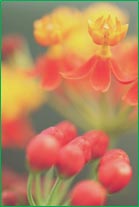 nine distinct displays.
nine distinct displays.
The design intent of the Floral Color Garden is to create an informal garden in which one could stroll in an alternate landscape; such as colored floral displays; laid out by colors,  starting with pink and working through red, orange, yellow, white, blue, purple and lavender and different natural habitats such as the wooded areas with native trees, and into open, grassy spaces.
starting with pink and working through red, orange, yellow, white, blue, purple and lavender and different natural habitats such as the wooded areas with native trees, and into open, grassy spaces.
 Visitors entering the Pink Garden at the entrance of the Floral Garden, pass under a pergola covered with flowing vines, entering the first section where you will find plants with pink flowers or coloration in the leaves, before you transition into the Red Garden. In the Red Garden you will notice that it is wooded and shady and is home to a large number of exotic looking foliage plants that thrive under the shade of our native trees. Some of the plants that
Visitors entering the Pink Garden at the entrance of the Floral Garden, pass under a pergola covered with flowing vines, entering the first section where you will find plants with pink flowers or coloration in the leaves, before you transition into the Red Garden. In the Red Garden you will notice that it is wooded and shady and is home to a large number of exotic looking foliage plants that thrive under the shade of our native trees. Some of the plants that  you may find here include Heliconias, Gingers, Crotons, and many more. This section of the color garden provides more of a feeling of a tropical rain forest than anywhere else in the Queen Elizabeth II Botanic Park.
you may find here include Heliconias, Gingers, Crotons, and many more. This section of the color garden provides more of a feeling of a tropical rain forest than anywhere else in the Queen Elizabeth II Botanic Park.
Moving from the tropical feeling you are now in the heat of the Orange Garden which features plants that enjoy being directly in the sunlight. The dramatic palms that seem to anchor the Orange Garden are Canary Islands Date Palms which exhibit orange fruit and are also home to many types of epiphytes.
From the heat of the Orange Garden we transition into the yellow garden which is also in a shaded area of the garden. This helps to display the various tones of yellow that you will find here, as they are more easily viewed against the contrast of the darker surroundings.
 The White Garden is next which opens up into a sunnier perspective and winds up to the gazebo where a display of water lilies can be viewed while relaxing here. At the gazebo you can view a lovely vista down the lake and other areas of the color garden. This area provides the first viewpoint of our lawn area which invites you to sit down and relax for awhile.
The White Garden is next which opens up into a sunnier perspective and winds up to the gazebo where a display of water lilies can be viewed while relaxing here. At the gazebo you can view a lovely vista down the lake and other areas of the color garden. This area provides the first viewpoint of our lawn area which invites you to sit down and relax for awhile.
Finishing out the Color Garden is the Blue Garden which encompasses three shades of color which are blue, purple and lavender. It is the largest area of the Floral Color Garden and its variety of plantings routinely change as new plantings are routinely introduced.
 Nearby, the two-acre Heritage Garden recreates a resourceful Caymanian way of life known generations ago, long before this country came to enjoy the highest standard of living in the Caribbean. This attraction’s main feature is the restored early 20th-century Rankin home, a traditional tiny three-room zinc-roofed Caymanian wooden cottage. Visitors are stunned when they learn that this structure once housed a family of 11 from infancy through adulthood. It was moved from its original location in the district of East End to the Park site in December 1995.
Nearby, the two-acre Heritage Garden recreates a resourceful Caymanian way of life known generations ago, long before this country came to enjoy the highest standard of living in the Caribbean. This attraction’s main feature is the restored early 20th-century Rankin home, a traditional tiny three-room zinc-roofed Caymanian wooden cottage. Visitors are stunned when they learn that this structure once housed a family of 11 from infancy through adulthood. It was moved from its original location in the district of East End to the Park site in December 1995.  The restoration features a porch, cook room with caboose, cistern, natural well, native coral stone fences and pathways lined with conch shells. Some of the original fixtures remain inside.
The restoration features a porch, cook room with caboose, cistern, natural well, native coral stone fences and pathways lined with conch shells. Some of the original fixtures remain inside.
Planning the Heritage Garden involved years of research on existing old gardens in the Cayman Islands. National Trust and Botanic Park staff first had to identify and locate traditional plants and unearth information about their planting style, providing the design for the surrounding two acres. When planning the Heritage Gardens, four elderly Caymanian ladies, considered authorities on the subject of traditional gardens, were invited to the Park to advise about plants commonly found in early gardens. As a result, visitors will discover a traditional Caymanian sand yard and garden with a variety of blooming plants including roses, orchids, hibiscus, crotons, lilies and cat bush.  One area of the garden is dedicated to tea bushes and medicinal herbs. There is also a collection of traditional fruit trees, including mango, breadfruit, tamarind, plum, cherry, ackee and chella mella. The Heritage Garden also features a section traditionally known as “grounds,” planted with “provisions” – vegetables including sweet potatoes, yams, cassava, okra, gungo peas, corn, plantains, bottlers and pumpkin.
One area of the garden is dedicated to tea bushes and medicinal herbs. There is also a collection of traditional fruit trees, including mango, breadfruit, tamarind, plum, cherry, ackee and chella mella. The Heritage Garden also features a section traditionally known as “grounds,” planted with “provisions” – vegetables including sweet potatoes, yams, cassava, okra, gungo peas, corn, plantains, bottlers and pumpkin.
 The Xerophytic Garden is a model for gardeners in the Cayman Islands who want to grow cactus or other low-maintenance plants that require little water. “Xerophytic refers to plants that are well suited to dry (xeric) conditions, such as cactus and certain succulents,” explains John Lawrus, the botanic park’s general manager. “This display garden will show both native, regional (Greater Antillean) and exotic plants that are tolerant of dry conditions.”
The Xerophytic Garden is a model for gardeners in the Cayman Islands who want to grow cactus or other low-maintenance plants that require little water. “Xerophytic refers to plants that are well suited to dry (xeric) conditions, such as cactus and certain succulents,” explains John Lawrus, the botanic park’s general manager. “This display garden will show both native, regional (Greater Antillean) and exotic plants that are tolerant of dry conditions.”
 “Using plants or ground covers as a substitute for lawns, incorporating the use of organic and inorganic mulches and the selection of drought tolerant plants which will be displayed in our garden, will provide a lower-cost garden alternative that limits the amount of water usage and the high costs that can be associated with it, as well as reduced maintenance,” he says.
“Using plants or ground covers as a substitute for lawns, incorporating the use of organic and inorganic mulches and the selection of drought tolerant plants which will be displayed in our garden, will provide a lower-cost garden alternative that limits the amount of water usage and the high costs that can be associated with it, as well as reduced maintenance,” he says.
Xerophytic plants may have adapted shapes and forms or internal functions that reduce their water loss or store water during long periods of drought. The benefits of a xerophytic garden include:
- Lower consumption of water.
- Less time and work needed for maintenance effort, with gardening simpler and less stressful.
- Xerophytic plants, in appropriate planting design and soil grading and mulching, take full advantage of rainfall retention.
- When water restrictions are implemented, xerophytic plants will tend to survive and thrive, while more ornamental plants may be unable to adapt.
 Xeriscaping means using local plants and drought tolerant plants that can grow and sustain themselves with low water requirements and tolerate heat and drought conditions. This does not mean only cacti and thorny succulents found in arid environments, but to any plant that can survive in this kind of environment such as ornamental grasses and flowering perennials. You can have a xeriscape without sacrificing color, texture or structure – the normal elements of any landscape.
Xeriscaping means using local plants and drought tolerant plants that can grow and sustain themselves with low water requirements and tolerate heat and drought conditions. This does not mean only cacti and thorny succulents found in arid environments, but to any plant that can survive in this kind of environment such as ornamental grasses and flowering perennials. You can have a xeriscape without sacrificing color, texture or structure – the normal elements of any landscape.
 The two-acre lake located near the southern end of the Botanic Park, just beyond the Floral Garden, is another important attraction. Completed in August 1996, the area was originally part of the adjacent swamp. Decades of accumulated muck was removed from the site leaving a two-acre brackish water lake approximately 3.5 feet deep. The area has three small islands with native vegetation in the center which provide an important habitat and
The two-acre lake located near the southern end of the Botanic Park, just beyond the Floral Garden, is another important attraction. Completed in August 1996, the area was originally part of the adjacent swamp. Decades of accumulated muck was removed from the site leaving a two-acre brackish water lake approximately 3.5 feet deep. The area has three small islands with native vegetation in the center which provide an important habitat and  breeding area for native birds that live near large bodies of water. The Lake has already become an active site for birdwatchers, attracting a fascinating range of bird life.
breeding area for native birds that live near large bodies of water. The Lake has already become an active site for birdwatchers, attracting a fascinating range of bird life.  Among species sighted have been Tricoloured Herons, Common Moorhen, Green Herons, Black-necked Stilts, American Coots, Blue-winged Teal, Cattle Egrets and rare West Indian Whistling Ducks.
Among species sighted have been Tricoloured Herons, Common Moorhen, Green Herons, Black-necked Stilts, American Coots, Blue-winged Teal, Cattle Egrets and rare West Indian Whistling Ducks.
On the southern edge of the lake, visitors see native wetland vegetation mingled with Caribbean plants. Eventually, the eastern portion of the lake, adjacent to the buttonwood swamp, will have a boardwalk where visitors can take leisurely strolls to the bird watching tower and lookout.
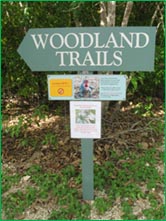 The Woodland Trail was built to allow Park patrons an opportunity to get inside the natural landscape since most of the Islands’ undisturbed forest is difficult to traverse. The trail is four-fifths of a mile long and can be comfortably walked. Care was spent mapping the site and the trail to ensure that it passes through unusual or significant habitats such as that of the very rare native Cockspur tree or a stand of Bull Thatch palms. The trail goes through swampy areas, dry areas, and some areas that have enough soil for larger trees such as Mahogany to develop lofty canopies. The land encompassed by the Woodland Trail makes up approximately forty acres, and is estimated to contain more than fifty percent of The Native Flora of the Cayman Islands.
The Woodland Trail was built to allow Park patrons an opportunity to get inside the natural landscape since most of the Islands’ undisturbed forest is difficult to traverse. The trail is four-fifths of a mile long and can be comfortably walked. Care was spent mapping the site and the trail to ensure that it passes through unusual or significant habitats such as that of the very rare native Cockspur tree or a stand of Bull Thatch palms. The trail goes through swampy areas, dry areas, and some areas that have enough soil for larger trees such as Mahogany to develop lofty canopies. The land encompassed by the Woodland Trail makes up approximately forty acres, and is estimated to contain more than fifty percent of The Native Flora of the Cayman Islands.
 The Orchid boardwalk features local orchids and more. During summer period, visitors to the Botanic Park can see our Cayman’s National Flower; the Wild Banana Orchid. The Queen Elizabeth II Botanic Park is home to ten of the twenty-eight orchid species recorded from the
The Orchid boardwalk features local orchids and more. During summer period, visitors to the Botanic Park can see our Cayman’s National Flower; the Wild Banana Orchid. The Queen Elizabeth II Botanic Park is home to ten of the twenty-eight orchid species recorded from the  Cayman Islands, and four of these are endemic (found nowhere else on earth).
Cayman Islands, and four of these are endemic (found nowhere else on earth).
Each year, the QEII Botanic Park hosts The Annual Orchid Show. This show is an exhibition of locally grown orchids and a plant sale of specially imported orchids, most of which are in bloom. Not only showcasing beautiful hybrid orchids, the Orchid Show promotes the conservation of Cayman’s native orchids. Typically held in late February, the event has also  become an occasion for educating gardeners on the techniques of growing orchids. The proceeds from the Show will go toward the establishment of an orchid garden in the Botanic Park.
become an occasion for educating gardeners on the techniques of growing orchids. The proceeds from the Show will go toward the establishment of an orchid garden in the Botanic Park.
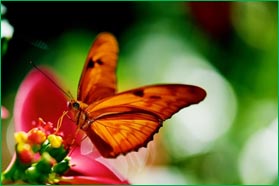 The Cayman Islands is home to over 60 butterfly species, five of which are endemic to these Islands, others are visitors and some are new residents. Their survival and ability to exist largely depends on the ability to provide and protect their food supplies or Host Plants within their environment or Habitat.
The Cayman Islands is home to over 60 butterfly species, five of which are endemic to these Islands, others are visitors and some are new residents. Their survival and ability to exist largely depends on the ability to provide and protect their food supplies or Host Plants within their environment or Habitat.
 Along the Woodland Trail lies the Blue Iguana Habitat, which is the center for the National Trust’s Blue Iguana Recovery Program. In 1995 the Park became the home for the National Trust for the Cayman’s Islands’ endemic Grand Cayman Blue Iguana captive breeding program, now seven years old. Currently more than 40 pure-bred endemic Grand Cayman Blue Iguanas are housed in the captive breeding and rearing facility.
Along the Woodland Trail lies the Blue Iguana Habitat, which is the center for the National Trust’s Blue Iguana Recovery Program. In 1995 the Park became the home for the National Trust for the Cayman’s Islands’ endemic Grand Cayman Blue Iguana captive breeding program, now seven years old. Currently more than 40 pure-bred endemic Grand Cayman Blue Iguanas are housed in the captive breeding and rearing facility.
 This endangered species, found only in Grand Cayman, is protected by Cayman law. (According to the Trust, only about 150 mature Blue Iguanas remain in the wild, found only in the dense interior of the eastern district of Grand Cayman.) Although this special research area is not open to visitors, the Park’s Blue Iguana Habitat remains a popular attraction. The habitat provides a natural home for an adult male blue iguana which can be seen by visitors. The best time to see the rare animal is mid-morning on sunny days, between 8:30 and 10:30 a.m.
This endangered species, found only in Grand Cayman, is protected by Cayman law. (According to the Trust, only about 150 mature Blue Iguanas remain in the wild, found only in the dense interior of the eastern district of Grand Cayman.) Although this special research area is not open to visitors, the Park’s Blue Iguana Habitat remains a popular attraction. The habitat provides a natural home for an adult male blue iguana which can be seen by visitors. The best time to see the rare animal is mid-morning on sunny days, between 8:30 and 10:30 a.m.
 Minister Jefferson, who’s Ministry oversees the Botanic Park’s development, said, “As a Caymanian I am very proud of our
Minister Jefferson, who’s Ministry oversees the Botanic Park’s development, said, “As a Caymanian I am very proud of our  Park and what it represents. It is the second youngest botanical facility in the Caribbean – and it won the prestigious Islands magazine ecotourism award shortly after it opened in 1994. Within its 65 acres, you will find more than 40 per cent of the 674 species of plants native to our country as well as many kinds of native birds and other wildlife. And new discoveries surprise us regularly: from proof discovered a few years ago that crocodiles once inhabited our swamplands to last year’s discovery of a species of orchid found for the first time anywhere in Cayman.”
Park and what it represents. It is the second youngest botanical facility in the Caribbean – and it won the prestigious Islands magazine ecotourism award shortly after it opened in 1994. Within its 65 acres, you will find more than 40 per cent of the 674 species of plants native to our country as well as many kinds of native birds and other wildlife. And new discoveries surprise us regularly: from proof discovered a few years ago that crocodiles once inhabited our swamplands to last year’s discovery of a species of orchid found for the first time anywhere in Cayman.”
 This heritage attraction was officially opened on 27th February, 1994 by Her Majesty Queen Elizabeth II and named in her honor. The next milestone was reached in May 1997, when Hon. Thomas Jefferson, Minister for Tourism, Commerce & Transport, officially opened three new attractions there: the Visitors Centre, Floral Garden and Heritage Garden, representing the Park’s second phase expansion program.
This heritage attraction was officially opened on 27th February, 1994 by Her Majesty Queen Elizabeth II and named in her honor. The next milestone was reached in May 1997, when Hon. Thomas Jefferson, Minister for Tourism, Commerce & Transport, officially opened three new attractions there: the Visitors Centre, Floral Garden and Heritage Garden, representing the Park’s second phase expansion program. 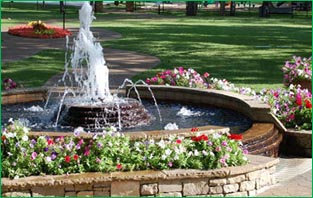 The Gardens are known for its natural beauty and picturesque gardens, and offers the perfect setting for a garden wedding, tea party, and a variety of celebratory events. The choices of setting range from lush alcoves and gazebos for intimate gatherings, to wide and immaculately groomed lawns that can comfortably accommodate up to 175 persons.
The Gardens are known for its natural beauty and picturesque gardens, and offers the perfect setting for a garden wedding, tea party, and a variety of celebratory events. The choices of setting range from lush alcoves and gazebos for intimate gatherings, to wide and immaculately groomed lawns that can comfortably accommodate up to 175 persons.
 “The Botanic Park is wonderful Cayman attraction for the whole family, and an important example of the Cayman Islands’ commitment to the preservation of our terrestrial environment. The new additions to the Park will provide both residents and visitors with the opportunity to enjoy and better understand this country’s diverse flora and fauna, which have played an important role in Caymanian culture,” said Minister Jefferson: “The Botanic Park offers a perfect setting for relaxing and enjoying the tropical
“The Botanic Park is wonderful Cayman attraction for the whole family, and an important example of the Cayman Islands’ commitment to the preservation of our terrestrial environment. The new additions to the Park will provide both residents and visitors with the opportunity to enjoy and better understand this country’s diverse flora and fauna, which have played an important role in Caymanian culture,” said Minister Jefferson: “The Botanic Park offers a perfect setting for relaxing and enjoying the tropical 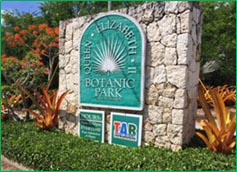 scenery of the Cayman Islands.” Come and see them all at the Q E II Botanic Park!
scenery of the Cayman Islands.” Come and see them all at the Q E II Botanic Park!
Located on Frank Sound Road in the district of North Side, the 65-acre Botanic Park is about a 45-minute drive from George Town, opens daily at 9:00 a.m. and closes promptly at 5:30 p.m. Visitors are advised to enter the park by 4:30 p.m. Admission fees are CI $10.00 for adults; $5.00 for children ages six to 12 and free for children under six.
